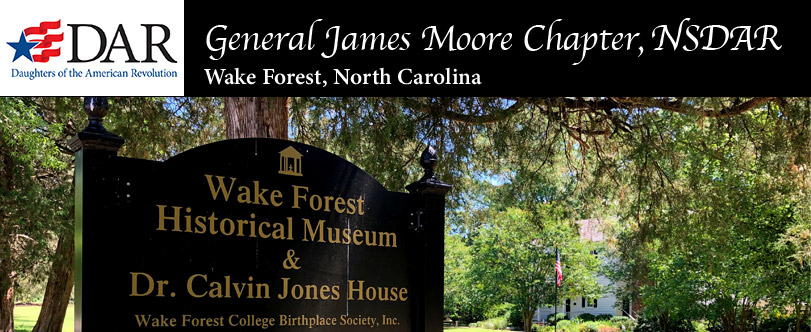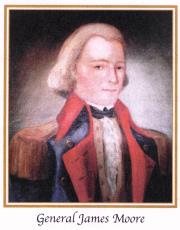
Chapter History
The General James Moore Chapter, NSDAR, was formed at the home of Organizing Regent Loula Hall Briggs Brewer on October 25, 1933. The general’s name was suggested as our chapter name by Albert Ray Newsome, Secretary of the North Carolina Historical Commission, and a strong advocate for the study and preservation of local history. The names of the regent and officers were telegraphed to the Organizing Secretary General in Washington, D.C. Other charter members were Petrona Powell Johnson, Susie Lanneau Powell, Grace Ward White, Nancy Leland McKaughan, Inez Keith Black, Mary E. Hall, Nannie Flintom Jones, Virginia Caldwell Lake, Leila Lankford Royall, Ada Lee Timberlake Utley, and Roselle McKinnon Wheelan.
Our chapter’s namesake, General James Moore, was born in 1737 in New Hanover County, North Carolina. His political and military family owned the Orton plantation in the Cape Fear River area. Moore helped organize the Wilmington Sons of Liberty and led a revolt against the Stamp Act. In February 1776, he distinguished himself in the Battle of Moore’s Creek Bridge. He skillfully maneuvered his forces between the Loyalists assembled at Cross Creek and their proposed rendezvous with British forces in Wilmington. Although he did not take part in the actual battle, Moore’s strategy was central to the American victory, its first decisive win in pitched battle. This stopped the British plan for the conquest of North Carolina. James Moore was promoted to brigadier general, being the first of only five North Carolina generals to serve in the Continental Army. After a winter encampment near Charleston, South Carolina, Moore returned to Wilmington to prepare his troops to march north to join General Washington. He was delayed due to the lack of money and supplies. James Moore became ill and died at home in April 1777, leaving his wife, Anne Ivey, and their four children. Moore was regarded at the time as the ablest military leader in North Carolina.
Since 1933, the General James Moore Chapter, NSDAR, has engaged continually in activities to support DAR goals. For example, in 1939, the chapter dedicated a marble headstone to mark the grave of Colonel Ransom Sutherland, a North Carolina Minuteman, who was buried at his home two miles northwest of Wake Forest. During WWII, chapter members supported blood drives and sold war bonds. The chapter acted as a sponsoring agent for the Red Cross Bloodmobile for over 30 years. During the 1950’s the chapter completed a project of furnishing every Wake Forest classroom with flags. Several state officers attended our chapter’s 30th anniversary tea on January 28, 1964, at the home of Regent Aycock. In 1970, the chapter presented its old handmade flag to the historic Calvin Jones House. In 1989, the chapter honored a Wake Forest’s favorite son. North Carolina Supreme Court Justice, Dr. I. Beverly Lake, was awarded the prestigious Medal of Honor, the highest honor bestowed upon a native citizen by the National Society. In 1997, the chapter presented a new flag to the town of Wake Forest. In 2018, our chapter donated a flagpole and marker to the Wake Forest Historical Museum. With more than 100 members today, the General James Moore Chapter, NSDAR, remains committed to the goals of historic preservation, promotion of education, and patriotism.
Photo this page courtesy of the chapter archives.
The content contained herein does not necessarily represent the position of the NSDAR. Hyperlinks to other sites are not the responsibility of the NSDAR, the state organizations, or individual DAR chapters.
